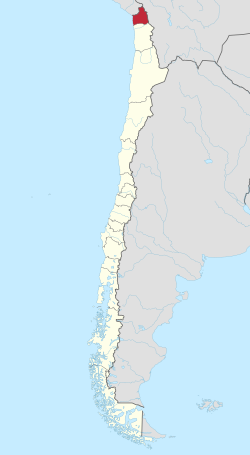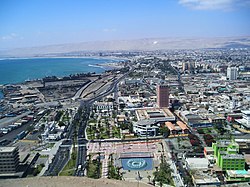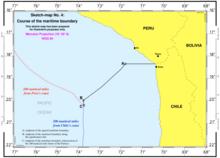Region of Chile
| Arica y Parinacota Region Región de Arica y Parinacota | |
|---|---|
| Region of Chile | |
 Parinacota Volcano and Chungará Lake Parinacota Volcano and Chungará Lake | |
 Flag Flag Coat of arms Coat of arms | |
 Map of Arica y Parinacota Region Map of Arica y Parinacota Region | |
| Coordinates: 18°28′30″S 70°18′52″W / 18.47500°S 70.31444°W / -18.47500; -70.31444 | |
| Country | |
| Capital | Arica |
| Provinces | Arica, Parinacota |
| Government | |
| • Intendant | Roberto Erpel (UDI) |
| Area | |
| • Total | 16,873.3 km (6,514.8 sq mi) |
| • Rank | 12 |
| Highest elevation | 6,342 m (20,807 ft) |
| Lowest elevation | 0 m (0 ft) |
| Population | |
| • Total | 224,548 |
| • Rank | 14 |
| • Density | 13/km (34/sq mi) |
| GDP (PPP) | |
| • Total | $2.315 billion (2014) |
| • Per capita | $9,848 (2014) |
| ISO 3166 code | CL-AP |
| HDI (2019) | 0.882 very high |
| Website | gorearicayparinacota |
The Arica y Parinacota Region (Spanish: Región de Arica y Parinacota pronounced [aˈɾikaj paɾinaˈkota]) is one of Chile's 16 first order administrative divisions. It comprises two provinces, Arica and Parinacota. It borders Peru's Department of Tacna to the north, Bolivia's La Paz and Oruro departments to the east and Chile's Tarapacá Region to the south. Arica y Parinacota is the 5th smallest, the 3rd least populous and the 6th least densely populated of the regions of Chile. Arica is the region's capital and largest city.
The region was a former Peruvian province, which was occupied by Chile under the 1883 Treaty of Ancón at the close of the War of the Pacific, and then formally annexed in 1929 by the Treaty of Lima. Following annexation, Arica y Parinacota went through a process of forced acculturation known as Chilenization with the aim of creating a dominance of Chilean traditions and culture.
Administration
In 2007, the region was subdivided to create the Arica y Parinacota region and the present day Tarapacá Region to the south. The region is further subdivided into two provinces: Arica and Parinacota.
| Region | Province | Commune | Area (km²) |
2002 Population |
Website |
|---|---|---|---|---|---|
| Arica y Parinacota | |||||
| Arica | |||||
| Camarones | 3,927 | 1,220 | link | ||
| Arica | 4,799 | 185,268 | link Archived 21 September 2010 at the Wayback Machine | ||
| Parinacota | |||||
| Putre | 5,903 | 1,977 | link | ||
| General Lagos | 2,244 | 1,179 | link | ||
Demography

According to data from the 2017 Census of the National Statistics Institute, the region is populated by 224,548 inhabitants. Its density reaches 13.3 inhabitants per km².
This region holds the largest population of Aymara and a significant number of immigrants from neighboring Peru and Bolivia. Included are those of Asian descent, such as Chinese and Japanese; and Arabs from Lebanon, Palestine and Syria. Most of the country's Afro-Chileans live in the Arica province, descended from slaves in the 17th and 18th centuries. There are a large number of Roma people or Gypsies in the Arica province as well, originated from Eastern Europe in the late 19th century.
At the level of cities, the most populated are: Arica, with 175,441 inhabitants and Putre, with 1235 inhabitants.
Geography

The region lies within the Norte Grande (Far North) natural region. It combines deserts, green valleys, the steep and volcanic Andes mountains, and the Altiplano (high plain) to the east. A narrow coastal strip of low-lying land no more than 2 kilometres (1 mi) wide separates the Pacific's Nazca Plate from the Andes. Its Parinacota volcano is the region's highest elevation at 6,348 metres (20,827 ft) and lies on the northern border with Bolivia in Lauca National Park.
Hydrology
The region's two main rivers are the Lauca, which drains into Bolivia's Coipasa salt flat (Lago Coipasa), and the Lluta, which flows into the Pacific Ocean. Lake Chungará at 4,517 metres (14,820 ft) above sea level ranks as one of the highest in the world.
Climate
A desert climate dominates the region. Near the coast, cloudiness can limit the temperature swing throughout the day, but in other drier areas, temperatures can vary greatly as is typical in deserts. A marginal desert region can be found over 3,000 m (9,843 ft) above sea level, which sees milder temperatures and summer rains.
Border dispute with Peru
Main article: Chilean–Peruvian maritime dispute

On 26 January 2007, Peru's government issued a protest against Chile's demarcation of the coastal frontier the two countries share. According to the Peruvian Foreign Ministry, the Chilean legislatures had endorsed a plan regarding the Arica y Parinacota region which did not comply with the current established territorial demarcation. Moreover, it is alleged that the proposed Chilean law included an assertion of sovereignty over 19,000 m (204,514 sq ft) of land in Peru's Department of Tacna. According to the Peruvian Foreign Ministry, Chile has defined a new region "without respecting the Concordia demarcation."
For its part, the Chilean government has asserted that the region in dispute is not a coastal site named Concordia, but instead refers to boundary stone No. 1, which is located to the northeast and 200 meters inland. A possible border dispute was averted when the Chilean Constitutional Court formally ruled on 26 January 2007, against the legislation. While agreeing with the court's ruling, the Chilean government reiterated its stance that the maritime borders between the two nations were not in question and have been formally recognized by the international community. The Peruvian government has stated that it might turn to the international court at The Hague to solve the dispute.
On 27 January 2014, in the final ruling of the International Court of Justice located in The Hague, Peru gained some maritime territory. The maritime boundary extends only to 80 nautical miles off of the coast. From that point, the new border runs in a southwest direction to a point that is 200 miles equidistant from the coast of the two countries.
Under the ruling, Chile lost control over part of its formerly claimed maritime territory and gives additional maritime territory to Peru.
From the 27 January 2014 court press release:
The Court concludes that the maritime boundary between the Parties starts at the intersection of the parallel of latitude passing through Boundary Marker No. 1 with the low-water line, and extends for 80 nautical miles along that parallel of latitude to Point A. From this point, the maritime boundary runs along the equidistance line to Point B, and then along the 200-nautical-mile limit measured from the Chilean baselines to Point C. In view of the circumstances of the case, the Court has defined the course of the maritime boundary between the Parties without determining the precise geographical co-ordinates.
Notable people
- Cristian Garín (born 30 May 1996), professional tennis player.
- Carolina Mestrovic (born 20 July 1991), singer, actress and TV host.
- Vlado Mirosevic (born 23 May 1987), member of the Chamber of Deputies of Chile
- Denisse van Lamoen (born 12 September 1979), first Chilean archer to compete at the Summer Olympics.
- Américo (born 24 December 1977), Tropical music and Chilean cumbia singer.
- Dante Poli (born 15 August 1976), football pundit and former player
- Manuel García (born 1 March 1970), folk-pop singer-songwriter and guitarist
- Humberto Donoso (1938–2000), former football player, played for Chile in the 1966 FIFA World Cup
- Guillermo Billinghurst (born 27 July 1851), former president of Peru
- Izkia Jasvin Siches Pastén (born 4 March 1986), President of Colegio Médico de Chile
- Osvaldo Hurtado (born 2 November 1957), former soccer player
- Sergio Hernández (born 27 April 1945), actor
See also
- Ancuta
- Atacama Desert
- Azapa Valley
- Caleta Vítor
- Chitita
- Chucuyo
- Climate of Chile
- Cosapilla
- Esquiña
- Geography of Chile
- Las Maitas
- List of volcanoes in Chile
- Molinos
- Poconchile
- Tignamar
References
- ^ "Arica-Parinacota Region". Government of Chile Foreign Investment Committee. Retrieved 13 March 2010.
- Regions and Cities > Regional Statistics > Regional Economy > Regional GDP per Capita, OECD.Stats.
- "Sub-national HDI – Area Database – Global Data Lab". hdi.globaldatalab.org. Retrieved 26 October 2021.
- "Iglesias de Arica Parinacota (Churches of Arica Parinacota)". New York: World Monuments Fund. Retrieved 26 July 2012.
However, San Pedro de Esquiña, like many other churches in the Arica y Parinacota region, is at risk.
- "Journalists and media professionals to participate in awareness-raising workshop on violence against women in Arica". UNESCO. 18 May 2011. Retrieved 26 July 2012.
several women's public organizations and agencies from the Chilean region of Arica y Parinacota.
- "Ley 20175. Crea la XV Región de Arica y Parinacota y la Provincia del Tamarugal en la Región de Tarapacá". Ley Chile (in Spanish). Valparaiso, Chile: Biblioteca del Congreso Nacional de Chile. 11 April 2007. Retrieved 26 July 2012.
- ^ "National Statistics Institute" (in Spanish). Retrieved 30 December 2010.
- ^ "Territorial division of Chile" (PDF). Archived from the original (PDF) on 14 November 2010. Retrieved 30 December 2010.
- "Asociacion Chilena de Municipalidades" (in Spanish). Archived from the original on 19 April 2011. Retrieved 7 February 2011.
- "De los pueblos indígenas de Chile" (PDF). transparencia.dgop.cl (in Spanish). Retrieved 28 August 2023.
- "Estadísticas Migratorias".
- "Africana – Memoria Chilena, Biblioteca Nacional de Chile".
- María Paz Rubilar Donoso. "Los Gitanos en Chile: de viajeros eternos a viajeros soñadores" (PDF). memoriachilena.gob.cl (in Spanish). Retrieved 28 August 2023.
- ^ "Peru protests against Chile's new definition of territory". Xinhua People's Daily online. Retrieved 27 January 2007.
- "Chilean court ruling averts looming border dispute with Peru - International Herald Tribune". Archived from the original on 29 January 2007. Retrieved 28 January 2007.
- "Peru-Chile Sea Dispute May Go to The Hague". Lima: Prensa Latina. 27 January 2007. Archived from the original on 25 October 2008. Retrieved 28 January 2007.
- CORDER, MIKE (27 January 2014). "World court draws new Peru-Chile maritime border". Associated Press. Retrieved 27 January 2014.
- "Archived copy" (PDF). Archived from the original (PDF) on 2 February 2014. Retrieved 30 April 2018.
{{cite web}}: CS1 maint: archived copy as title (link)
External links
- Constitutional Court sentence (in Spanish)
| Regions of Chile | ||
|---|---|---|
| Provinces and communes in the Arica y Parinacota Region | ||
|---|---|---|
| Arica |  | |
| Parinacota | ||
